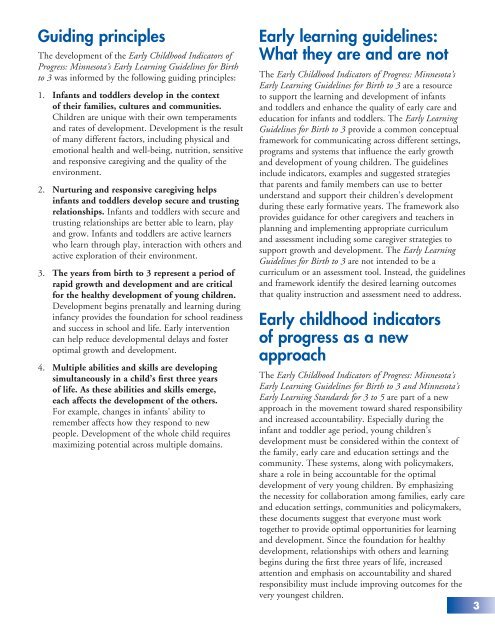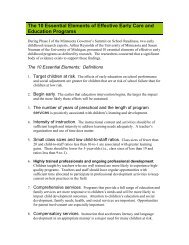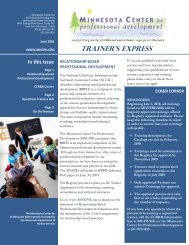Birth to 3
Minnesota's Early Learning Guidelines for Birth to 3 - The Minnesota ...
Minnesota's Early Learning Guidelines for Birth to 3 - The Minnesota ...
- No tags were found...
Create successful ePaper yourself
Turn your PDF publications into a flip-book with our unique Google optimized e-Paper software.
Guiding principlesThe development of the Early Childhood Indica<strong>to</strong>rs ofProgress: Minnesota’s Early Learning Guidelines for <strong>Birth</strong><strong>to</strong> 3 was informed by the following guiding principles:1.2.3.4.Infants and <strong>to</strong>ddlers develop in the contex<strong>to</strong>f their families, cultures and communities.Children are unique with their own temperamentsand rates of development. Development is the resul<strong>to</strong>f many different fac<strong>to</strong>rs, including physical andemotional health and well-being, nutrition, sensitiveand responsive caregiving and the quality of theenvironment.Nurturing and responsive caregiving helpsinfants and <strong>to</strong>ddlers develop secure and trustingrelationships. Infants and <strong>to</strong>ddlers with secure andtrusting relationships are better able <strong>to</strong> learn, playand grow. Infants and <strong>to</strong>ddlers are active learnerswho learn through play, interaction with others andactive exploration of their environment.The years from birth <strong>to</strong> 3 represent a period ofrapid growth and development and are criticalfor the healthy development of young children.Development begins prenatally and learning duringinfancy provides the foundation for school readinessand success in school and life. Early interventioncan help reduce developmental delays and fosteroptimal growth and development.Multiple abilities and skills are developingsimultaneously in a child’s first three yearsof life. As these abilities and skills emerge,each affects the development of the others.For example, changes in infants’ ability <strong>to</strong>remember affects how they respond <strong>to</strong> newpeople. Development of the whole child requiresmaximizing potential across multiple domains.Early learning guidelines:What they are and are notThe Early Childhood Indica<strong>to</strong>rs of Progress: Minnesota’sEarly Learning Guidelines for <strong>Birth</strong> <strong>to</strong> 3 are a resource<strong>to</strong> support the learning and development of infantsand <strong>to</strong>ddlers and enhance the quality of early care andeducation for infants and <strong>to</strong>ddlers. The Early LearningGuidelines for <strong>Birth</strong> <strong>to</strong> 3 provide a common conceptualframework for communicating across different settings,programs and systems that influence the early growthand development of young children. The guidelinesinclude indica<strong>to</strong>rs, examples and suggested strategiesthat parents and family members can use <strong>to</strong> betterunderstand and support their children’s developmentduring these early formative years. The framework alsoprovides guidance for other caregivers and teachers inplanning and implementing appropriate curriculumand assessment including some caregiver strategies <strong>to</strong>support growth and development. The Early LearningGuidelines for <strong>Birth</strong> <strong>to</strong> 3 are not intended <strong>to</strong> be acurriculum or an assessment <strong>to</strong>ol. Instead, the guidelinesand framework identify the desired learning outcomesthat quality instruction and assessment need <strong>to</strong> address.Early childhood indica<strong>to</strong>rsof progress as a newapproachThe Early Childhood Indica<strong>to</strong>rs of Progress: Minnesota’sEarly Learning Guidelines for <strong>Birth</strong> <strong>to</strong> 3 and Minnesota’sEarly Learning Standards for 3 <strong>to</strong> 5 are part of a newapproach in the movement <strong>to</strong>ward shared responsibilityand increased accountability. Especially during theinfant and <strong>to</strong>ddler age period, young children’sdevelopment must be considered within the context ofthe family, early care and education settings and thecommunity. These systems, along with policymakers,share a role in being accountable for the optimaldevelopment of very young children. By emphasizingthe necessity for collaboration among families, early careand education settings, communities and policymakers,these documents suggest that everyone must work<strong>to</strong>gether <strong>to</strong> provide optimal opportunities for learningand development. Since the foundation for healthydevelopment, relationships with others and learningbegins during the first three years of life, increasedattention and emphasis on accountability and sharedresponsibility must include improving outcomes for thevery youngest children.3








